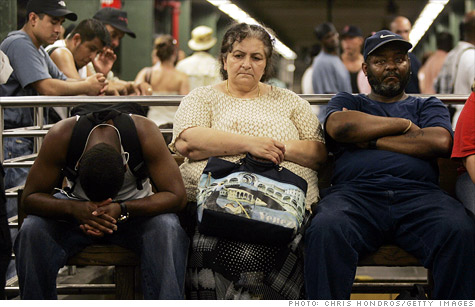
ABC News quoted an unnamed White House spokesperson, saying the November jobs report provides "further evidence that the economy is continuing to heal."
Obama's Chairman of the Council of Economic Advisers Alan Krueger hyped the 0.4% unemployment rate drop to 8.6%, "the lowest (figure) since March 2009." He didn't explain why. More on that below, including the real unreported employment rate.
The New York Times tried having it both ways. On December 2, Catherine Rampell's article headlined, "Jobless Rate Dips to Lowest Level in More Than 2 Years," saying:
"Somehow the American economy appears to be getting better, even as the rest of the world is looking worse."
She called it "good news for President Obama as he heads into the 2012 presidential election - especially since just a few months ago the picture looked bleak."
For America's 26 million unemployed, it never looked bleaker. It's reflected in what Bureau of Labor Statistics (BLS) figures and major media scoundrels don't report - the nation's near-23% unemployment rate (including millions wanting work but dropped out for lack of jobs), its highest since the Great Depression.
A same day Times editorial more accurately explained conditions headlined, "Been Down So Long...," saying:
Despite a reported 120,000 new jobs created at a time nearly double that's needed to keep up with population growth and people entering the workforce, the unemployment rate drop "was not because jobless people found new work."
"Rather, it is because 315,000 people dropped out of the work force, a reflection of extraordinarily weak demand by employers for new workers."
In fact, 349,000 adult women dropped out last month at a time seasonals should have stimulated new hiring through Christmas.
"It is also a sign of socioeconomic decline, of wasted resources and untapped potential, the human equivalent of boarded-up Main Streets and shuttered factories."
The editorial stopped short of explaining a protracted Main Street Depression expected to last years because austerity measures adopted and (others planned) are wrongheaded, not stimulative to reignite growth.
The Times partly noted that most new jobs are low-pay, low-benefit temporary or part-time ones. At the same time, manufacturing is slowing, construction is flat, and most higher-paying jobs went overseas.
On December 1, Times writer Mokoto Rich headlined, "For Jobless, Little Hope of Restoring Better Days," citing research showing most people who lost jobs in recent years now work harder for less. Many, in fact, experience what they call a drastic, likely irreversible, income and benefit decline.
Against this backdrop, heavy lifting is needed to stimulate growth to put people back to work. Instead, austerity's hitting people harder when they most need help.
The November Jobs Report
On December 2, Zero Hedge posted Lance Roberts' analysis headlined, "The Real Employment Situation Report,"saying:
Seasonals during the holiday period should have produced stronger jobs growth. Those created fell far short of "return(ing) the country to full, healthy employment."
Discouraged worker dropouts show weak employment conditions. Most jobs created are low-pay part-time or temp ones. Numbers of unemployed, including long-term ones, show Depression, not recovery conditions.
Also factor "fudge" in every report. Numbers released are estimates plus or minus huge totals. The Labor Department says "(t)he confidence level for the monthly change in total employment is on the order of plus or minus 430,000 jobs."
In other words, in good times, data may accurately or understate employment growth, but during today's hard times (a Main Street depression), it's mirror opposite.
In fact, 2011 revisions to 2010 data removed one million reported jobs. Expect similar or greater downward revisions next year.
Monthly reports also include "birth/death" adjustments. They're based on estimates of net non-reported jobs from new businesses minus losses from others no longer operating.
During expansions, the model works because start-ups exceed shut-downs. It doesn't in recessions. Yet the BLS assumes employees from non-operating companies are still there. In addition, BLS figures add 30,000 jobs monthly whether or not new companies exist.
As a result, monthly calculations during hard times way overstate employment levels. Headline numbers are misleading. The true picture is manipulated to hide reality.
It includes growing numbers of discouraged workers. Many are no longer eligible for unemployment benefits.
In November, 86.5 million people weren't counted in labor force figures, including 487,000 new ones (dropouts) last month. In fact, if no one dropped out last month, headline U-3 unemployment would have been 11%.
Notably, labor force participation fell to its lowest level in three decades. Long-term unemployment hit a record high 40.9 weeks.
The private payroll diffusion index also plunged from 59.6 to 54.7, the lowest level since September 2010. Moreover, manufacturing employment diffusion dropped from 52.5 in October to 49.4. It shows factories are shedding, not creating jobs.
In fact, it was the third decline in the past four months. It suggests a broad-based slowing in what's been the economy's main driver since 2009.
Other disturbing data included declining goods-producing payrolls. Down 6,000, they dropped three of the past four months, their worst showing since early 2010.
In addition, aggregate hours worked gained a tepid 0.1% for the second straight month. It shows economic weakness, not strength. Average weekly earnings reflected it - down 0.1% for the second time in the past four months.
Worse still is global contagion. Nearly every country with manufacturing diffusion indices reported below 50. It shows contraction, not expansion.
Whether or not atmospheric warming is real, economic cooling is accelerating as nations experience hard times. Europe is especially hard hit, but its trouble is heading west.
Stephen Lendman lives in Chicago and can be reached at lendmanstephen@sbcglobal.net.
Also visit his blog site at sjlendman.blogspot.com and listen to cutting-edge discussions with distinguished guests on the Progressive Radio News Hour on the Progressive Radio Network Thursdays at 10AM US Central time and Saturdays and Sundays at noon. All programs are archived for easy listening.

No comments :
Post a Comment